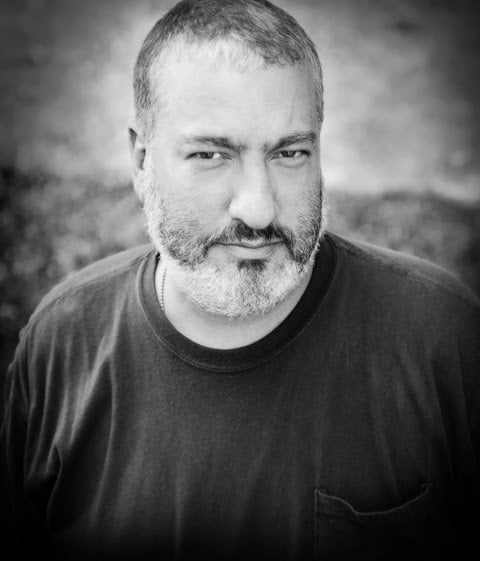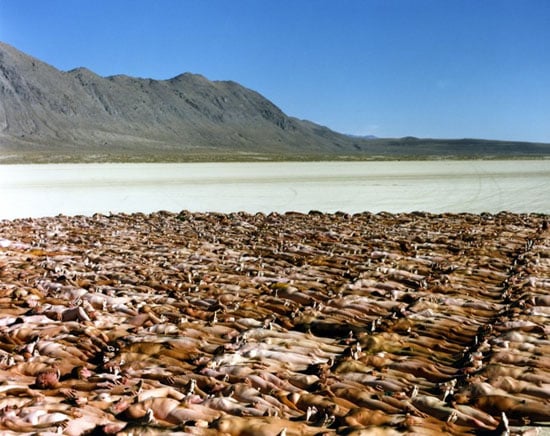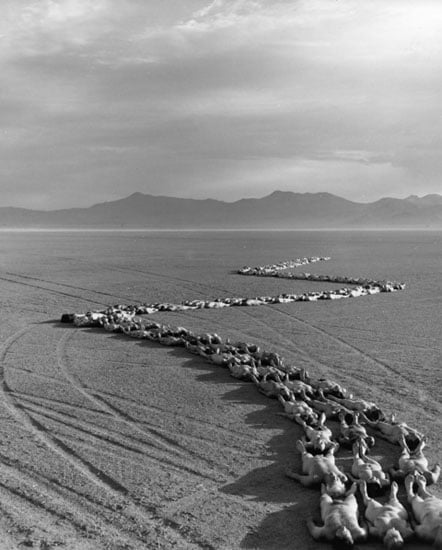Interview with Artist-Photographer Spencer Tunick
![]()
You know his work. You may have been one of the thousands of people who exposed their hidden beauty and the flaws that all humans have on their physical being to be a part of something magnificent.
His photographs of nude bodies are immediately recognizable. The same can’t be said of his subjects en masse. Humanity in all shapes, sizes and colors coalesce with each other and nature’s beauty. They form tessellations that wind through architectural wonders. His subjects become human cityscapes.

Spencer Tunick has been photographing nude groups and individuals in public spaces since 1992. The New York artist was arrested five times in his own city. He travels the world creating provocative images that spark controversy, but also speak to the part of us that is seeking that human connection. Spencer’s respect for the individual and the group are evident in his work.
Speaking with Spencer, you can see how he engages strangers and earns their trust. He’s unpretentious and he has a droll sense of humor. His photographs are in the permanent collections of prestigious galleries, museums and personal collections. He has been the subject of a number of documentaries.
We had the pleasure of speaking with Spencer about his inspiration, his process and his upcoming Burning Man project, Desert Spirits.
What I love about your work and what amazes me the most is that many people need their personal space. They don’t want to touch or be touched by strangers, at least in North America. Inspiring strangers to press together and allow their bodies to touch in that way is an incredible thing.
Spencer Tunick: Some of my works that I have done in the past, people are right up arm to arm, leg to leg, strangers not touching intimate parts, but just external friendly parts. Not that your sexual organs aren’t friendly.
I think what happens there is the body becomes one organism and it’s a very interesting thing to look at. Some of my most memorable works are when the bodies are very close together sort of forming a sea of flesh as opposed to seeing sand or pavement between the bodies.
For the work that I am doing at Burning Man, people are going to be wearing translucent fabric over their individual bodies and they won’t be touching, so this project is a little bit different.

Your website has a section for participants to apply to be in your photographs. Do you have a certain kind of body type your are looking for?
ST: Any type of body type. We have incredibly large people to very thin women and men. Asian, African American (any color). We have a large contingent of different kinds of people. The reason why I’m trying to get people registered this year, is that this fabric we have is very expensive, even though we got it down here in Mexico. It’s a very sheer thin fabric that you might see in a hotel window which might diffuse the light, not block it. It’s either nylon or polyester and it’s incredibly thin, so it looks like someone’s a spirit or a ghost underneath the fabric. People will be nude under the fabric, but they won’t be 100 percent nude.
Burning Man is probably the one place that you don’t have to try to convince people to get naked.
ST: Oh, I know. Usually my past Burning Man projects, there has never been a limit on how many people we needed. As many people that show up, we will take. For this one, we just have so much fabric. Even though we have a limit, the mechanism for me to gather people has to be different. I’m trying to make people go one more step to register, so they’re really committed, by emailing a photo of themselves.
This is just one more step that they have to take, and for me, that’s more dedication that they actually might have a better chance of showing up so we might get a more definite count on numbers. With that said, we haven’t done anything to get the word out there yet except post on their events list with hundreds and hundreds of other projects, so we’re sort of lost in the mix.
My work, you can’t just walk down the playa and find people, you have to register to be part of it. People who are interested can register at [email protected].
Do they have to be there at a certain time?
ST: We definitely need people. They’ll have an incredible morning. They’re not naked at five in the morning, that is just the time that they come. They’re naked right before the sun hits the horizon and as the warm sun hits their bodies. The reason why I do it at sunrise; if I wanted that same light, I’d have to do it at sunset, but I’d probably have 30,000 people watching. Here, Most of the people of Burning Man are sleeping while I do this work.
Do participants get a copy of the photograph?
ST: All the participants get a copy, a free piece of artwork that I mail to them. It’s great, sell it on eBay and buy yourself next year’s tickets.
You have so many people that want to be in your photographs that you don’t have to hunt them down. You must get hundreds of requests.
ST: For my individual portraits, I still look for a person’s appearance to match the idea I’m working with. For my group works, it’s really difficult to get people naked in Germany, and naked in Switzerland. It’s very difficult to get people naked in London and all parts of England. But it’s not difficult to get people naked in Australia. In Latin America and South America, it’s not difficult.
It really depends country to country. It’s a lot of work. In some European countries, even though you think Europeans are used to going to the beach naked and sunbathing, the act of participating in an artwork is sometimes a totally different mindset. I haven’t done one in the United States in some time. It will be interesting to see if I did work in a major city what the turnout would be.
Canada is no problem. Everyone wants to get naked in Canada.

Your first book, European Installations, looks amazing. Can you tell us about that?
ST: My new book was designed by Krissy [Kristin Bowler, Spencer’s wife]. She’s my graphic designer. It’s home grown, I didn’t go through the corporate book world. I did it myself, although it was on press for the same printer that prints for San Francisco Museum of Modern Art (SFMOMA). It has that museum quality. It’s just sold by myself because why not do it yourself? It’s the age of Internet commerce.
Why do you think people want to be in your photos? I’ve read testimonials. It really makes a difference in some people’s lives; women with issues about body image who felt free and more accepting of their bodies afterward. I thought that was such a touching and wonderful thing.
ST: I think being nude in a group is a grand equalizer. I think it makes you feel better about yourself and your connection to the earth and other people. It’s a great feeling. I must say, if a thousand people pose for me, maybe one person won’t like it because they can’t find their clothes after. They eventually find their clothes.
The process of making it is very democratic and we try to include instead of exclude. In the contemporary art world, it’s all about purchasing and monetary value and it’s not often someone gets a gift from an artist. It’s nice that people can start having collections of my photography. Some people have posed for me more than once and they have a small wall gallery of my work. It’s nice to be able to give something back for free.
I’ve been doing that since I started. That’s from when I used to work with 100 people on the streets of New York and then meet at this bar called Max Fish a month later and hand them all prints in exchange for posing and have a little party. Even when I worked with 18,000 people in Mexico City, three months later, they got their prints. So, in total, I have over 100,000 artworks in people’s homes, all gifts. Very nice.
Recently, one of those eight by ten inch photographs was put up for auction in the Phillips Contemporary Art Auctions by someone who posed with her husband in Switzerland. It went for $7,000 U.S. It’s a rare thing, but not only is it a gift, there is an opportunity to have something that’s a small investment. It didn’t start out like that. I used to trade my small contact sheets in New York City bars for drinks. Now my small contact sheets could buy me, like a whole bottle.
I’m sure a lot of other photographers and artists have been inspired by your work. A lot of people do nudes, but no one really does it the way you do it.
ST: Now, if you look at nudes online, there is always some photographer shooting a nude in the streets or somewhere in public. When I first started doing it, I don’t think that there was anyone doing as consistently as I was. Maybe in their repertoire of works they might have wandered out into the streets and done a nude. I’m just talking hypothetically. So there wasn’t anyone working consistently on the streets, at least in New York. Maybe one or two people. Now everyone does it.
Whenever I look at a photographer’s body of work, if they have nudes in it, there’s nudes in public. I’m talking about individuals. As far as groups works, before me there was Yayoi Kusama, who did group works in public, maybe with six or seven people. Carolee Schneemann, a great feminist artist from the 60’s, she had some public works in nature with people nude. When I started doing it, I didn’t know anyone doing big groups of people. I think at the same time, Vanessa Beecroft starting doing clothed groups of people, but not naked people. She started doing nudes maybe a year or two after myself. She’s been doing it for years. There is this great artist, Santiago Sierra, who works with groups and the body. Japan is another story, there are a lot of people doing group nudes that are more overtly sexual, maybe 500 people having sex in a big indoor space.
I have a specific vision and I love the results of what I’m doing. It still excites me. I still think when I’m doing my work in foreign cities where I haven’t done it before, it still rocks the city where I’m working and turns it upside down and changes the mindset of a city for at least a week. I continue to really enjoy how the work affects people in foreign countries. That’s why my next work is going to be in South America, and there’s interest in the Canary Islands again for my work. We’ll see what happens.
I love what you did at La Calaca Festival and your new exhibit that’s opening August 3, in San Miguel de Allende, Mexico, The Good, The Bad and The Visionary
ST: I collaborated with a musician and artist named Joseph Arthur. I brought him my friends – 15 people including my wife, and they painted themselves all white and then he did his signature style of painting on their bodies. I printed the photographs on canvas and brought them back to him and he repainted over the photographs again. The works are beautiful.
We have an exhibition of that collaboration. He is one of the only art musicians out there who can paint and play music at the same time. He does that occasionally. It’s hard to get away with that, but he is the real thing. He’s kind of undiscovered in a way for doing that, it’s masterful and beautiful. He’s coming out for the exhibition here in San Miguel de Allende, Mexico. That’s where I am now.

The La Calaca Festival happened last year, and my project was to turn people into spirits and to cover them with these clear sheets. My Desert Spirits project at Burning Man is bringing my La Calaca series to Burning Man, so it’s San Miguel de Allende, the La Calaca Festival in Burning Man. Hopefully the people who visit Burning Man can one day visit San Miguel de Allende and come to the La Calaca Festival during Day of the Dead because it’s just amazing. It’s a town on steroids and it’s just so beautiful. There’s a lot of burners that come to San Miguel de Allende and live here.
It’s a four hundred year old town surrounded by natural hot springs that come up through crystal rock and you soak in the day and drink tequila all night. We spend our summers here now. The kids get out of school in New York and we head right here. It’s actually less expensive with kids to live here in the summer than stay in New York.
How old are your kids now? Do they come to your shoots?
ST: Six and eight. Yes, definitely, they enjoy my work. They try to take all my postcards. Kids just see all these little people on postcards that are naked and they think they are fairies.
Have you had any corporations approach you to do commercial work?
ST: Yes, yes, I’ve had Dove Soap, Vaseline, Diesel Jeans, Lipton Iced Tea, Virgin Mobile, and Microsoft and I’ve said no to all of them. Sometimes my wife and I lie down in bed at night and say “We could be rich!” I just can’t sell out. My work is so recognizable, I just can’t be the artist that makes a big symbol for CBS or for whatever.
You know what I mean, it would take my heart away from my work. Although there are artists that are much more established than me that do commercial work, contemporary artists, they can hide behind it, their style doesn’t come through as much as mine would. So they can do it and be a successful commercial photographer and be in the art world. It’s just hard for me to do it and feel good about myself.
You have shared your work to raise awareness for certain causes.
ST: I did a work to raise awareness about HIV, where I photographed 80 HIV positive people in the west village all together in a diner where the owner had his T cell count on a board in the restaurant because he was HIV positive. His name is Florent Morellet. There is actually a documentary about him and his diner, Florent, where a lot of the gay and lesbian community would congregate in the late 80s and 90s. I did that.
Then Greenpeace approached me to do a work that wasn’t so much an advertisement for them, it was more that I could make it my work and they gave me the incredible tools to do works on a glacier with mountaineers. I could make whatever I wanted, and they just wanted the people posing and me to think about the fragility of the largest glacier in Europe and how it is melting at an incredible rate. They wanted to send some press to cover the making of my art and attach a message to it, not to the art itself, but just to the process of making it. So it was a very wonderful thing to be able to send out a message, make my work uncompromised and work in this incredible natural location of the Swiss Alps. It’s pretty awesome when your work can go beyond just being self-serving and inspire a message that is very important.

Those photographs were awe-inspiring. How did you get the people there?
ST: They were very helpful. The Swiss Rail System gave everyone free tickets from wherever they were coming from in Switzerland to the location. They came from all over Switzerland. They got up probably at three in the morning, and the call time was at seven. We had to get up the mountain and then hike down to the glacier so that we didn’t start shooting until midday. We were all so very lucky to have a break in the sky where there was sun, so everything worked out.
How many times have you done shoots at Burning Man?
ST: This will be my fourth time. My first work was in 1997, my second was in 1999 and my third was in 2000. The population has tripled so it will be interesting to see what it is like. I’m most interested in seeing the people. I think that is the best art at Burning Man, the people. And then, I’m interested in seeing the structures and different communal art projects. I’m very excited to see it visually and I hope I enjoy it as much as I did in 2000.
Thank you, Spencer. It’s been a privilege speaking with you.
This interview originally appeared at Ignite.me
Image credits: Portrait of Tunick by Itzuvit/Wikipedia, all other photos by Spencer Tunick